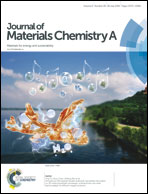Anchoring and space-confinement effects to form ultrafine Ru nanoclusters for efficient hydrogen generation†
Abstract
Developing highly efficient, durable, and low-cost catalysts for the hydrogen evolution reaction (HER) is an eternal pursuit for scientists to replace Pt-based catalysts. The fundamental ways to boost the performance of electrocatalysts are improving the intrinsic activity of each active site and increasing the number of exposed active sites. Herein, we report a novel approach to synthesize ultrafine Ru nanocluster catalysts embedded in a nitrogen-doped carbon framework. To illustrate this strategy, Ru atoms are immobilized in tetra-aminephthalocyanine (RuPc-NH2) by Ru–N4 bonds and subsequently confined by graphene oxide (GO) nanosheets in space. After pyrolysis treatment, ultrafine Ru nanoclusters (average size 1.03 ± 0.23 nm) stabilized by an N-doped carbon framework with a 23.7 wt% Ru content (Ru@NG) are prepared. Importantly, Ru@NG shows excellent HER performance with small overpotentials (20.3 mV in 1.0 M KOH and 42.7 mV in 0.5 M H2SO4) at 10 mA cm−2, a high active site number (3.54 × 10−3 mol g−1) and robust durability both in alkaline and acidic environments. Therefore, this work provides a promising substitute for expensive Pt-based catalysts.



 Please wait while we load your content...
Please wait while we load your content...